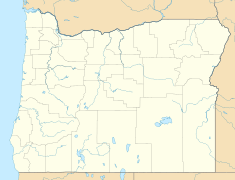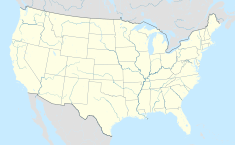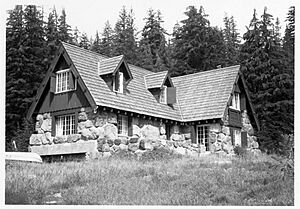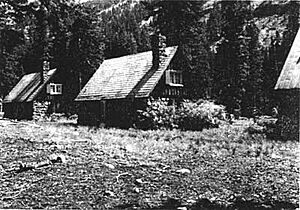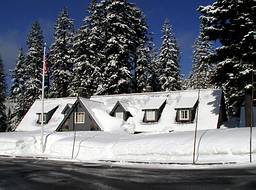Munson Valley Historic District facts for kids
|
Munson Valley Historic District
|
|
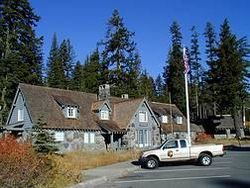
The Crater Lake National Park administration building at Munson Valley.
|
|
| Location | Crater Lake National Park, Oregon |
|---|---|
| Nearest city | Fort Klamath, Oregon |
| Area | 7.5 acres (3.0 ha) (original) 6 acres (2.4 ha) (decreased) |
| Built | 1926 |
| Architect | National Park Service, Merel Sager |
| Architectural style | National Park Service rustic |
| MPS | Crater Lake National Park MRA |
| NRHP reference No. | 88002622 97001154 (decrease) |
Quick facts for kids Significant dates |
|
| Added to NRHP | December 1, 1988 |
| Boundary decrease | September 18, 1997 |
The Munson Valley Historic District is a special area in Crater Lake National Park in southern Oregon. It's where the park's main offices and support buildings are located. The National Park Service chose Munson Valley because it's in the middle of the park.
The buildings here have a unique "rustic" style. This means they look natural and blend in with the park's landscape. Because of this special design, the area was listed as a historic district in 1988. This means it's a place with important history and architecture. The district has eighteen important buildings. One of them, the Crater Lake Superintendent's Residence, is a U.S. National Historic Landmark.
Contents
Discovering Crater Lake's Past
Crater Lake was formed about 7,700 years ago. A huge volcano called Mount Mazama collapsed after a giant eruption. Over thousands of years, rain filled the giant hole, creating the deep blue lake we see today. The Klamath Indians thought Crater Lake was a very special place.
In 1853, three gold miners found the lake. They called it Deep Blue Lake. But because it was so high up in the Cascade Mountains, people soon forgot about it.
William Steel and the Park Idea
In 1886, a man named William Gladstone Steel visited Crater Lake. He was with a group from the United States Geological Survey. They even brought a half-ton boat, the Cleetwood, and lowered it into the lake! During this trip, Steel named many famous spots like Wizard Island.
Steel was amazed by the lake's beauty. When he returned home, he started working hard to make Crater Lake a national park.
Building the Park's First Roads
On May 22, 1902, President Theodore Roosevelt signed a bill. This made Crater Lake the sixth national park in the United States. The United States Department of the Interior was in charge of building roads and visitor services. This was tough because the park was so remote.
By 1905, a "steep and winding" road to the lake's edge was finished. This road was very important for the park's future.
In 1913, the government gave money to the United States Army Corps of Engineers to build a road around Crater Lake. They decided that the northern part of Munson Valley was the best spot for their road crew's headquarters. It was a central location, and there was plenty of timber nearby for building. However, World War I slowed down construction. The road around the lake was finally completed in 1918. After that, the National Park Service kept using Munson Valley for new building projects.
Munson Valley: From Camp to Headquarters
By 1924, the Munson Valley area was known as "Government Camp." It became the park's summer headquarters. But the buildings were not well-designed and were built cheaply.
In 1925, the National Park Service made a plan for Munson Valley. They started building in 1927. Thomas C. Vint oversaw the project. The plan included new offices, a maintenance area, homes for park staff, and other support buildings.
New Buildings in a Rustic Style
Between 1927 and 1930, several buildings were constructed. These included a park warehouse, a dining hall, and small cottages. All these buildings were designed in a "rustic" style. They used wood from nearby trees and stone from local quarries.
From 1932 to 1936, more homes were built. These were for the park superintendent, the park naturalist, and other employees. A dormitory for park rangers was also completed. The old log headquarters building was replaced with a new stone one.
The area in front of the new administration building was landscaped. It had an island in the middle and parking for 50 cars. During this time, Civilian Conservation Corps crews planted thousands of trees and shrubs. They also added small features like stone paths and drinking fountains. In 1938, "Government Camp" was officially renamed "Park Headquarters."
Building work at Crater Lake National Park slowed down during World War II. The park staff mainly focused on keeping things running. This led to a period where park facilities started to decline.
Park Headquarters: Adapting to Winter
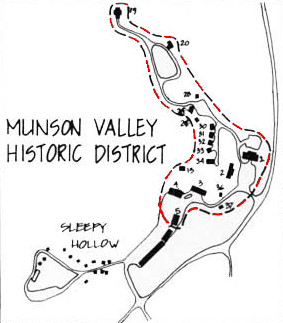
2. Ranger dormitory
3. Mess hall
4. Warehouse
5. Machine shop
8. Oil and gas house
13. Meat house
19. Superintendent's residence
20. Naturalist's residence
24, 25, 28, 30, 31, 32. Residences
33. Stone shed/garage
34. Hospital
36. Transformer building
37. Comfort station Munson Valley Historic District has 18 buildings.
After World War II, the National Park Service started using the Munson Valley complex all year round. This caused big changes. Many paths and gardens had to be removed. Roads were widened to make space for snow plows. Some porches were taken off, and snow tunnels were added to buildings for winter access.
In 1954, all the gardens and paths around the employee cottages were removed. This made it easier to clear snow. Other changes happened over the years too. Some older buildings were taken down.
Even with these changes, the headquarters still looks like the original plan. It's a great example of the National Park Service's rustic architecture. That's why it was listed as a historic district in 1988. The historic area was first about 7.5 acres but was later made smaller to 6 acres.
Important Buildings in the District
There are eighteen main buildings in the Munson Valley Historic District. Most of them have been updated. But they still show the rustic style that makes this area special.
The district stretches from the Superintendent's Residence in the north to the park warehouse in the south. These eighteen historic buildings were built between 1926 and 1949.
- The park Superintendent's Residence was built in 1933. It has a stone base and a wood-shake roof. The first floor has a living room with a lava-rock fireplace, a dining room, kitchen, and a bedroom. The second floor has four more bedrooms. Today, this building is part of the park's Science and Learning Center. It is also a U.S. National Historic Landmark.
- The park Naturalist's Residence is near the Superintendent's Residence. It has a similar size but a slightly different layout inside. It has a living room with a stone fireplace, a kitchen, and bedrooms. Today, it also houses part of the park's Science and Learning Center.
- The district also has six rustic stone Employee Cottages. These were built between 1927 and 1931 for park staff. They are important because they were part of the original plan for Munson Valley. They were built using local stone and wood. Even though they got new roofs in the 1950s, they still look like they did originally.
- The park Administration Building has a rough stone first floor and a rustic upper part. The main entrance leads to a public lobby with a large fireplace. Offices for the superintendent and other staff are on the first floor. The second floor has more offices and storage rooms.
- The Ranger Dormitory was started in 1932 and finished in 1936. It's made of local stone and wood. It used to have living rooms and bathrooms for both men and women. Today, the National Park Service uses this building as its main visitor center. It's called the William G. Steel Information Center. Visitors can get maps, permits, and learn about the park here. First aid is also available.
The historic district also includes other useful buildings. These include a dining hall, a meat house, a transformer building, a comfort station (now a sign shop), a warehouse, and a machine shop. All these buildings share similar design features. They have strong stone walls, rough wood siding, and steep roofs. These features are typical of the park's rustic style.
At Munson Valley, these rustic buildings fit in well with nature. They are great examples of this architectural style. The landscape around the historic district also looks much like it did in the past. This makes Munson Valley Historic District an important example of American natural design.
Getting to Munson Valley
Munson Valley is high up in the Cascade Mountains, about 6,450 feet above sea level. It is about 60 miles north of Klamath Falls, Oregon. The Munson Valley Historic District is about 3 miles south of Crater Lake. The Rim Village visitor area is also nearby.
In the Crater Lake area, winter lasts about eight months. There's a lot of snow, and many snow banks stay until summer. Most park roads close in winter. However, the park headquarters, visitor center, and other Munson Valley facilities are open all year. But winter storms can make driving tricky. In summer, the weather is usually warm, but nights can be cool.
The National Park Service charges a fee to enter the park.
Images for kids


